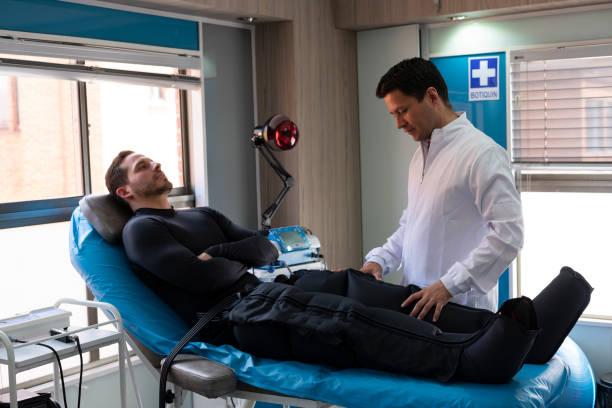
At Merse Wellness Spa, we understand the rigorous demands of athletic performance and the necessity for optimal recovery solutions. Compression therapy, an innovative approach embraced by athletes worldwide, aids in accelerating recovery times, improving blood circulation, and enhancing overall athletic performance.
Table of Contents
ToggleCompression wear is engineered to exert graduated compression, which means tighter pressure at the extremities and lesser as it moves up the limb. During athletic activities, this increased circulation can bring about several performance-enhancing effects:
This functionality directly ties into recovery, as the same principles that help during performance also facilitate quicker recovery periods. The enhanced circulation helps to flush out metabolic wastes like lactic acid more efficiently. Additionally, the reduced muscle vibration diminishes the risk of microtraumas, the tiny tears in muscle fibres that can occur during intense exercises.
Incorporating compression therapy into an ongoing training routine can yield substantial long-term benefits. Athletes who consistently use compression garments report fewer injuries, which can be attributed to the consistent support and reduced strain on muscles and joints. Moreover, the psychological confidence of feeling ‘supported’ can significantly affect performance, allowing athletes to push harder and with more focus during training and competition.
To get the most out of compression therapy, it’s crucial to understand how to integrate it effectively into your routine. Here are some tips:
Compression therapy operates on a fundamental principle: by applying controlled pressure to specific body parts, it enhances blood flow and facilitates the removal of waste products from muscle tissues. For athletes, this means recovery processes commence immediately after physical exertion, significantly reducing recovery time and improving performance.
Graduated compression, the cornerstone of effective compression therapy, involves applying pressure that gradually decreases from the lower parts of the body towards the heart. This gradient supports the natural movement of blood against gravity, enhancing circulation during both intense physical activity and recovery periods.
The benefits of compression therapy are not confined to endurance athletes alone. Strength athletes, team sports players, and recreational fitness enthusiasts can all gain from the advantages of compression garments.
For compression therapy to be effective, it must be used correctly. Here are some guidelines to ensure that athletes get the maximum benefit from their compression garments:
The technology behind compression garments is continuously evolving, with new materials and designs constantly emerging. These innovations aim to enhance comfort, fit, and physiological benefits. Advanced fabrics now offer better moisture-wicking properties, greater durability, and precise levels of compression, tailored to different parts of the body and various types of sports.
To maximise the effectiveness of compression therapy, it’s advisable for athletes to consult with sports health professionals. These experts can provide valuable insights into the most appropriate types of compression wear for different activities, the ideal pressure levels, and the most effective usage patterns. Understanding the use and impact of compression therapy helps in optimising recovery and enhancing performance, making it a crucial consideration for those involved in rigorous sports and exercises.
Merse Wellness Spa frequently hosts sessions and workshops led by sports medicine professionals who specialise in athletic recovery and performance enhancement. These experts explain the nuances of compression therapy and how to integrate it seamlessly into training routines.
Every athlete’s body responds differently to compression therapy, making personalisation crucial. Factors such as the specific sport, level of activity, personal health considerations, and recovery goals should guide the choice and use of compression garments on our blog. Regular assessment and adjustment of compression therapy protocols can help athletes achieve the best outcomes, ensuring tailored and effective solutions are implemented.
Compression therapy offers a plethora of benefits for athletes looking to enhance performance and expedite recovery. At Merse Wellness Spa, we provide expert advice and high-quality compression solutions tailored to your athletic needs. Contact us today to learn more about how compression therapy can be integrated into your training regime.
Compression therapy includes socks, sleeves, tights, and full-body suits, each targeting different body parts.
It’s recommended to wear compression garments for 1 to 2 hours post-exercise to maximise recovery benefits.
Yes, by stabilising muscles and improving blood flow, compression therapy can reduce the risk of muscle strains and ligament sprains.
When used appropriately, compression therapy is safe. However, wearing compression wear that is too tight for prolonged periods could potentially cause issues.
It’s essential to select the size and pressure of the garment according to your body measurements and personal comfort levels.
Yes, compression garments can be used daily, especially if you are engaged in regular training or recovering from an injury.